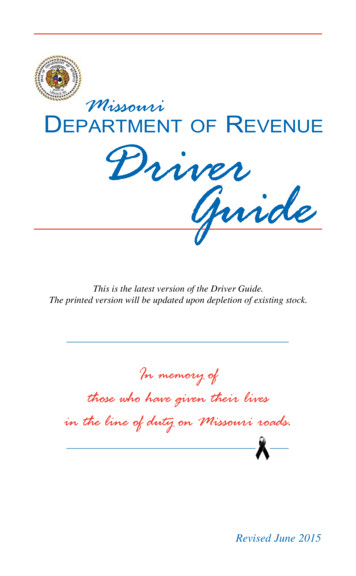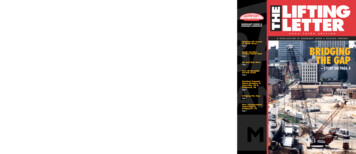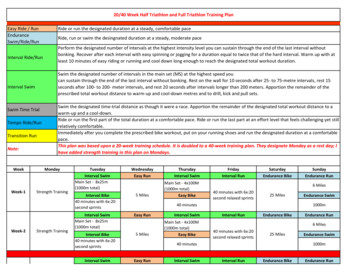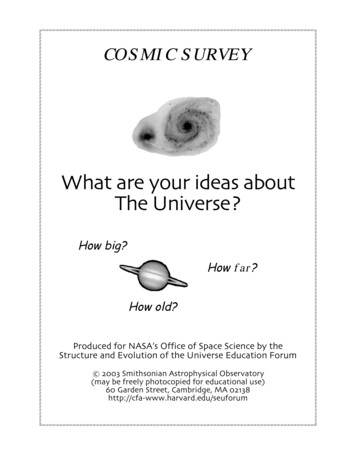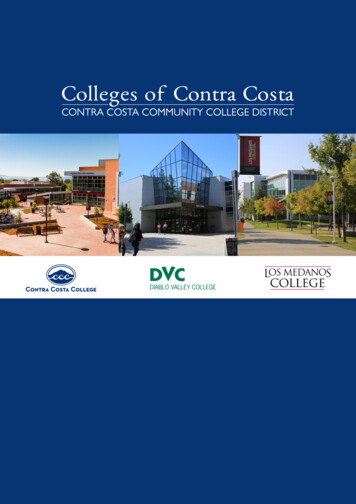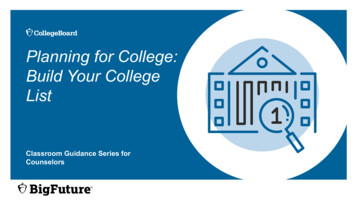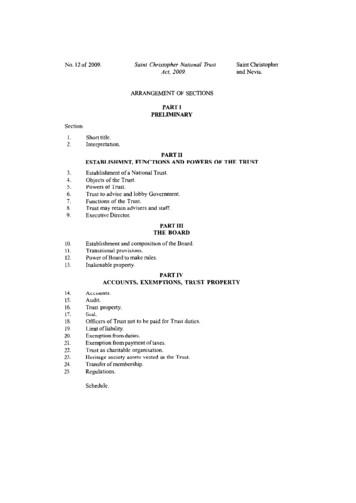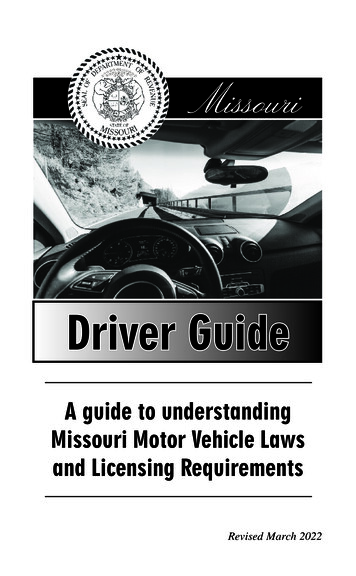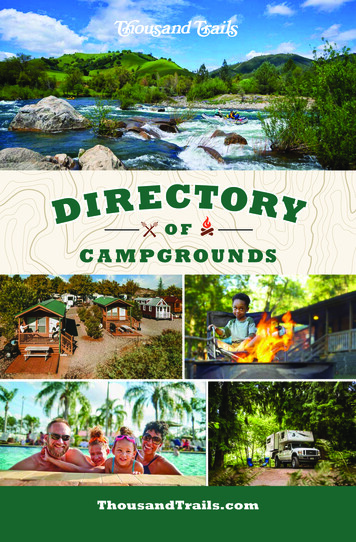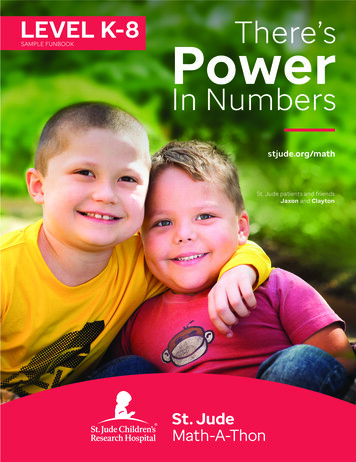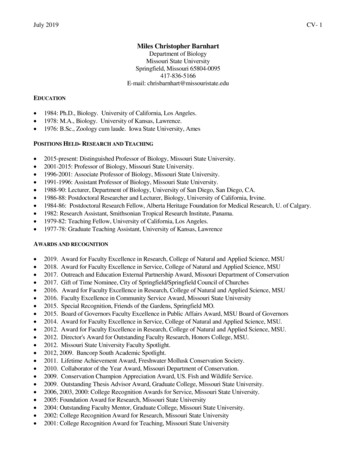
Transcription
July 2019CV- 1Miles Christopher BarnhartDepartment of BiologyMissouri State UniversitySpringfield, Missouri 65804-0095417-836-5166E-mail: chrisbarnhart@missouristate.eduEDUCATION 1984: Ph.D., Biology. University of California, Los Angeles.1978: M.A., Biology. University of Kansas, Lawrence.1976: B.Sc., Zoology cum laude. Iowa State University, AmesPOSITIONS HELD- RESEARCH AND TEACHING 2015-present: Distinguished Professor of Biology, Missouri State University.2001-2015: Professor of Biology, Missouri State University.1996-2001: Associate Professor of Biology, Missouri State University.1991-1996: Assistant Professor of Biology, Missouri State University.1988-90: Lecturer, Department of Biology, University of San Diego, San Diego, CA.1986-88: Postdoctoral Researcher and Lecturer, Biology, University of California, Irvine.1984-86: Postdoctoral Research Fellow, Alberta Heritage Foundation for Medical Research, U. of Calgary.1982: Research Assistant, Smithsonian Tropical Research Institute, Panama.1979-82: Teaching Fellow, University of California, Los Angeles.1977-78: Graduate Teaching Assistant, University of Kansas, LawrenceAWARDS AND RECOGNITION 2019. Award for Faculty Excellence in Research, College of Natural and Applied Science, MSU2018. Award for Faculty Excellence in Service, College of Natural and Applied Science, MSU2017. Outreach and Education External Partnership Award, Missouri Department of Conservation2017. Gift of Time Nominee, City of Springfield/Springfield Council of Churches2016. Award for Faculty Excellence in Research, College of Natural and Applied Science, MSU2016. Faculty Excellence in Community Service Award, Missouri State University2015. Special Recognition, Friends of the Gardens, Springfield MO.2015. Board of Governors Faculty Excellence in Public Affairs Award, MSU Board of Governors2014. Award for Faculty Excellence in Service, College of Natural and Applied Science, MSU.2012. Award for Faculty Excellence in Research, College of Natural and Applied Science, MSU.2012. Director's Award for Outstanding Faculty Research, Honors College, MSU.2012. Missouri State University Faculty Spotlight.2012, 2009. Bancorp South Academic Spotlight.2011. Lifetime Achievement Award, Freshwater Mollusk Conservation Society.2010. Collaborator of the Year Award, Missouri Department of Conservation.2009. Conservation Champion Appreciation Award, US. Fish and Wildlife Service.2009. Outstanding Thesis Advisor Award, Graduate College, Missouri State University.2006, 2003, 2000: College Recognition Awards for Service, Missouri State University.2005: Foundation Award for Research, Missouri State University2004: Outstanding Faculty Mentor, Graduate College, Missouri State University.2002: College Recognition Award for Research, Missouri State University2001: College Recognition Award for Teaching, Missouri State University
July 2019 CV- 22000-2004: University Fellow, Missouri State University.2000: Silver Award, Radio News Feature, with Don Hendrix and Mike Smith, KSMU Radio.Council for the Advancement and Support of Education.1999, 1997: University Recognition Awards for Research. Missouri State University.1995: Summer Faculty Fellowship. Missouri State University.1994: Excellence in Teaching Award. Missouri State University.1984-1986: Postdoctoral Fellow, Alberta Heritage Foundation for Medical Research1984: Robert Lasiewski Award for Excellence in Research, University of California, Los Angeles.1978-1982: Chancellor's Intern Fellow, University of California, Los Angeles.1976-1978: University of Kansas Graduate School Honors Fellowship, University of Kansas.1976: Thomas H. MacBride Scholarship in Natural Sciences, University of Iowa.1976: Phi Beta Kappa, Iowa State University.1976: Sigma Xi Undergraduate Research Scholar, Iowa State University.1974: N.S.F. Undergraduate Research Program Participant, Iowa State University.PUBLICATIONS - CAREER SUMMARY 72 peer-reviewed journal articles and books46 technical reports to funding agencies30 articles in popular press, instructional manuals, newsletters and abstractsPUBLICATIONS – LAST 10 YEARS (PEER REVIEWED ONLY) Seagroves, L. Ashley, M. Chris Barnhart, Thom Hardy, and Astrid N. Schwalb. 2019. Reproductiveecology of the threatened and endemic freshwater mussel Lampsilis bracteata. Aquatic Conservation:Marine and Freshwater Ecosystems 2019: 1–11.Ferreira-Rodríguez, Noe, M. Christopher Barnhart, et al. 2019. Research priorities for freshwater musselconservation assessment. Biological Conservation 231, March 2019, Pages 77-8Barnhart, M.C. 2018. Forward. In: Patterson, M., et al. Freshwater Mussel Propagation for Restoration.Elsevier Press, 272 p.Louise Lavictoire, A.D. Ramsey, E.A. Moorkens, G. Souch, and M.C. Barnhart. 2018. Ontogeny ofjuvenile freshwater pearl mussels, Margaritifera margaritifera (Bivalvia: Margaritiferidae) PLOS 1:https://doi.org/10.1371/journal.pone.0193637Ning Wang, James Kunz, Chris Ivey, Chris Ingersoll, Chris Barnhart, Elizabeth Glidewell. 2017. Toxicityof Chromium (VI) to two mussels and an amphipod in Water-Only Exposures with or without a co-stressorof elevated temperature, zinc, or nitrate. Archives of Environmental Contamination and Toxicology. DOI:10.1007/s00244-017-0377-xCavallaro, Michael C., M. Christopher Barnhart, and W. Wyatt Hoback. 2017. Causes of rapid carrionbeetle (Coleoptera: Silphidae) death in flooded pitfall traps and tests of soil flooding, immersion tolerance,and swimming behavior. Environmental Entomology Environmental Entomology, 46(2), 2017, 362–368.doi: 10.1093/ee/nvw165Wang, N., Ivey, C. D., Ingersoll, C. G., Brumbaugh, W. G., Alvarez, D., Hammer, E. J., Bauer, C. R.,Augspurger, T., Raimondo, S. and Barnhart, M. C. 2016. Acute sensitivity of a broad range of freshwatermussels to chemicals with different modes of toxic action. Environ Toxicol Chem. doi:10.1002/etc.3642Douda, K., Martin, M., Glidewell, E., Barnhart, C. 2016. Stress-induced variation in host susceptibility toparasitic freshwater mussel larvae. Hydrobiologia 1-9, DOI: 10.1007/s10750-016-2895-3.Leonard, Jeremy A., W. Gregory Cope, Tom Augspurger, Edward J. Hammer, M. Christopher Barnhart, andRobert B. Bringolf. 2016. Extending the toxicity-testing paradigm for freshwater mussels: Assessingchronic reproductive effects of the synthetic estrogen 17α-ethinylestradiol on the unionid mussel Elliptiocomplanata. Comp. Biochem. Physiol. Part C Toxicology & Pharmacology. Sep 2016.
July 2019 CV- 3Boogaard, M.A., T.J. Newton, T.D. Hubert, C.A. Kaye, M.P. Henson, and M.C. Barnhart. 2015.Evaluation of the acute toxicity of 3-trifluoromethyl-4-nitrophenol (TFM) to multiple life stages ofEpioblasma triquetra and its host fish (Percina caprodes). Environmental Toxicology and Chemistry34(7):1634-41.Leonard, J.A., W.G. Cope, M.C. Barnhart, R.B. Bringolf. 2014. Metabolomic, behavioral, andreproductive effects of the aromatase inhibitor fadrozole hydrochloride on the unionid mussel Lampsilisfasciola. General and Comparative Endocrinology, 206: 213–226Leonard, J.A., W.G. Cope, M.C. Barnhart, and R.B. Bringolf. 2014. Metabolomic, behavioral, andreproductive effects of the synthetic estrogen 17alphaethinylestradiol on the Unionid mussel Lampsilisfasciola. Aquatic Toxicology 150:103–116.Miller, E.J., J.J. Tomasic and M.C. Barnhart. 2014. A comparison of freshwater mussels (Unionidae) froma Late-Archaic archeological excavation with recently sampled Verdigris River, Kansas populations.American Midland Naturalist 171:16–26.Fritts, A.K., M.C. Barnhart, M. Bradley, N. Liu, E. Hammer, W.G. Cope, W. Gregory, and R. Bringolf.2014. Assessment of toxicity test endpoints for freshwater mussel larvae (glochidia). EnvironmentalToxicology and Chemistry 33 (1), 199-207.Hazelton, P.D., W.G. Cope, S. Moshe, T.J. Pandolfo, J.B. Belden, M.C. Barnhart, R.B. Bringolf. 2013.Fluoxetine alters adult freshwater mussel behavior and larval metamorphosis. Science of the TotalEnvironment 445-446:94–100.Hinck, J.E., M.C. Barnhart et al. 2012. Conserving mussel diversity in the Meramec River basin, Missouri,USA. Journal of Fish and Wildlife Management 3(2): 319-331.Hazelton, P., G. Cope, T. Pandolfo, S. Mosher, M. Strynar, C. Barnhart, R. Bringolf. 2012. Partial lifecycle and acute toxicity of perfluoroalkyl acids to freshwater mussels. Environmental Toxicology andChemistry 31(7):1611-20.McMurray, S. M. C. Barnhart, S. Faiman, A. Roberts, B. Simmons. 2012. Field Guide to MissouriMussels. Missouri Department of Conservation. 94p.Crane, A.L., A.K. Fritts, A. Mathis, J.C. Lisek, and M.C. Barnhart. 2011. Do gill parasites influence theforaging and antipredator behaviour of rainbow darters, Etheostoma caeruleum? Animal Behaviour 82:817823Wang, Ning, R.A. Consbrock, C.G. Ingersoll, and M. C. Barnhart. 2011. Evaluation of influence ofsediment on the sensitivity of a unionid mussel (Lampsilis siliquoidea) to ammonia in 28-day waterexposures. Environmental Toxicology and Chemistry 30 (10): 2270–2276.Tiemann, J.S., S.E. McMurray, M.C. Barnhart, and G.T. Watters. 2011. Review of the Interactionsbetween Catfishes and Freshwater Mollusks in North America. In: "Conservation, Ecology, & Managementof Worldwide Catfish Populations & Habitats". American Fisheries Society Symposium 77:733–743.Miao, Jingjing, M.C. Barnhart, E. L. Brunson, D.K. Hardesty, C.G. Ingersoll, N. Wang. 2011. Lack ofinfluence of substrate on the sensitivity of juvenile freshwater mussels (fatmucket, Lampsilis siliquoidea) tothe acute toxicity of ammonia. Environmental Toxicology and Chemistry, Vol. 29, No. 9, pp. 2112–2116.Pandolfo, T.J., W.G. Cope, C. Arellano, R.B. Bringolf, M.C. Barnhart, E. Hammer. 2010. Beating the heat:upper thermal tolerances of early life stages of freshwater mussels. Journal of the North AmericanBenthological Society 29(3):959–969Wang, N., C.G. Ingersoll, C.D. Ivey, D.K. Hardesty, T.W. May, A.D. Roberts, T. Augspurger, E. vanGenderen, and M.C. Barnhart. 2010. Sensitivity of early life stages of freshwater mussels (Unionidae) toacute and chronic toxicity of lead, cadmium, and zinc. Environmental Toxicology and Chemistry.Chemistry, Vol. 29, No. 9, pp. 2053–2063.Wang, N., C.A. Mebane, J.L. Kunz, C.G. Ingersoll, T.W. May, W.R. Arnold, R.C. Santore, T. Augspurger,F.J. Dwyer, and M.C. Barnhart. 2009. Evaluation of acute copper toxicity to juvenile freshwater mussels(fatmucket, Lampsilis siliquoidea) in natural and reconstituted waters. Environmental Toxicology andChemistry. 28(11):2367-2377. doi:10.1897/08-655.1.Barnhart, M. C. 2008. A compact recirculating system for laboratory culture of freshwater bivalves.Hatchery International Jan/Feb 2008. p. 27.
July 2019 CV- 4Barnhart, M. C., W. R. Haag & W. N. Roston. 2008. Adaptations to host infection and larval parasitism inthe Unionoida. Journal of the North American Benthological Society 27(2): 370-394.Cope, W. G., R. B. Bringolf, D. B. Buchwalter, T. J. Newton, C. G. Ingersoll, N. Wang, T. Augspurger, F. J.Dwyer, M. C. Barnhart, R. J. Neves, and E. Hammer. 2008. Differential exposure, duration, and sensitivityof unionoidean bivalve life stages to environmental contaminants. Journal of the North AmericanBenthological Society. 27(2): 451-462.Pandolfo, Tamara J., W. Gregory Cope, Robert B. Bringolf, and M. Christopher Barnhart. 2008.Sensitivity of early life stages of freshwater mussels to a range of common and extreme water temperatures.Proceedings: Second Thermal Ecology and Regulation Workshop: October 2 3, 2007. EPRI, Palo Alto,CA: 2008. 1016809. Pages 10-1 - 10-7.Serb, J. M. and M. C. Barnhart. 2008. Congruence and conflict between molecular and reproductivecharacters when assessing biological diversity in the western fanshell Cyprogenia aberti (Bivalvia:Unionidae). Annals of the Missouri Botanical Garden 95(2): 248-261.Wang, N., R. J. Erickson, C.G. Ingersoll, C.D. Ivey, E.L. Brunson, T. Augspurger, and M. C. Barnhart.2008. Influence of pH on the toxicity of ammonia to juvenile mussels (fatmucket, Lampsilis siliquoidea).Environmental Toxicology and Chemistry 27(5):1141–1146.PRESENTATIONS - CAREER SUMMARY 257 presentations at professional meetings, authored or coauthored.61 invited presentations, 7 keynote or plenary.PRESENTATIONS – LAST 5 YEARS2019. Biennial Symposium of the Freshwater Mollusk Conservation Society, San Antonio, Texas April 14-18. Wang, Ning, Chris Barnhart, Jordan Murray, and 12 others. 2019 Method Development for Short-TermEffluent Test with a Freshwater Mussel (Lampsilis siliquoidea).2019. Invited Seminar, Columbia Environmental Research Center, Columbia, MO 4-5-19 Barnhart, Chris. Sacrificial clams: freshwater mussels in the context of toxicology.2019. EPA Safe and Sustainable Water Resources Research Program webinar: M and M’s: DevelopingMethods to Detect Toxicity in Water using Mayflies and Mussels. 3-27-19 Wang, Ning, James L. Kunz, Jeffery A. Steevens, Edward J. Hammer, Candice R. Bauer, and M. ChrisBarnhart. Method development for short-term effluent test using a freshwater mussel, Lampsilissiliquoidea.2019. Interior Highlands Mollusk Conservation Committee, Neosho MO March 13-14 Sapp, Regina and Chris Barnhart. Effects of chronic hypoxia on survival and growth of juvenilefreshwater mussels. Sieja, Allison and Chris Barnhart. 2019. Competition between invasive Asian clams and nativefreshwater mussels. Stegmann, Eric and Chris Barnhart. 2019. Habitat selection and host detection in the Salamandermussel, Simpsonaias ambigua. Barnhart, Chris and Louise Lavictoire. Allometry of filtration rate and gill development in juvenilefreshwater mussels.
July 2019CV- 52019. SETAC Europe Annual Meeting, Helsinki, Finland, May 26-31. Norberg-King, Teresa, Ning Wang, James L. Kunz, Jeffery A. Steevens, Edward J. Hammer, CandiceR. Bauer, and M. Chris Barnhart. Development of Short-Term Toxicity Test Methods to EstimateChronic Toxicity using the Freshwater Mussel (Fatmucket, Lampsilis siliquoidea).2019 Biennial Symposium of the Freshwater Mollusk Conservation Society, San Antonio, Texas April 14–18. Ning Wang, J. Kunz, D. Hardesty, J. Steevens, T. Norberg-King, E. Hammer, C. Bauer, T.Augspurger,S.Dunn, D.Martinez, Chris Barnhart, Jordan Murray, M. Bowersox, J.Roberts, R.Bringolf, R.Ratajczak,S.Ciparis, G.Cope, S.Buczek, Daniel Farrar, Lauren Rabalais, Mailee Garton, Patricia Gillis, JimBennett, Joseph Salerno, Brian Hester, Richard Lockwood, Chris Tarr, Dennis McIntyre, JonathanWardell. METHOD DEVELOPMENT FOR SHORT-TERM EFFLUENT TESTS WITH AFRESHWATER MUSSEL (FATMUCKET, LAMPSILIS SILIQUOIDEA).2019. Invited seminar, NIWA, Hamilton, New Zealand. 1-15-19 Barnhart, Chris. Freshwater Mollusks for Toxicology.2018. Freshwater Mollusk Conservation Society Workshop: Freshwater Mollusk Health and DiseaseAssessment, La Crosse, Wisconsin, March 13-15, 2018 Kern, Morgan, Louise Lavictoire, Megan Bradley, Nathan Eckert, and Chris BarnhartPests, predators, parasites, and related problems in the culture of freshwater mussels.2017. Ocean University, Qingdao, PRC. Barnhart, M. C. Invited Lecture, Ocean University, Qingdao, PRC. "Conservation Significance offreshwater mussels in the USA. Invited Lecture, Ocean University, Qingdao, PRC. Barnhart, M. C. Biogeographic connections between China and Eastern North America. Invited Lecture,Ocean University, Qingdao, PRC.2017. 10th Biennial Symposium of the Freshwater Mollusk Conservation Society. Cleveland, OH Kern, Morgan A. Beth Glidewell and Chris Barnhart, Simplifying methods for in vitro metamorphosis ofglochidia. Loyd, Kendell, Beth Glidewell, Chris Barnhart, Bernard Sietman, and Mike Davis. Synchronization ofreproduction by temperature in deertoe mussel (Truncilla truncata). Martin, Kathryn C., Beth Glidewell, and Chris Barnhart. Upper thermal limits of freshwater mussels(Bivalvia, Unionoida) in ramped temperature exposures. Maynard, Bryce, Chris Barnhart, and Marc Owen. A year-long mark-recapture study of the threatenedRabbitsfoot Mussel (Quadrula cylindrica cylindrica). Moore, Adrian P., Robert B. Bringolf, and M. Christopher Barnhart. Use of partial lifecycle tests todetermine effects of nitrate and an estrogen on fatmucket (Lampsilis siliquoidea).2016. 4th Interior Highlands Mollusk Conservation meeting. Tahlequah, OK Maynard, Bryce and Chris Barnhart. Linking shell morphology to the reproductive behavior of thethreatened Rabbitsfoot mussel (Quadrula cylindrica cylindrica). Maynard, Amy, Laszlo Kovacs and Chris Barnhart. Sex-associated mitochondrial genes: tools forunderstanding Unionid reproduction and development. Kern, Morgan and Chris Barnhart. Simplifying methods for in vitro metamorphosis of glochidia. Loyd, Kendell and Chris Barnhart. Testing the possible role of chemoreception in spawning of DeertoeMussel (Truncilla truncata). Martin, Kathryn and Chris Barnhart. Critical thermal limits of freshwater mussels in ramped temperatureexposures. Glidewell, Beth, Amy Maynard, James Kunz, Ning Wang and Chris Barnhart. Culturing early juvenilemussels in pulsed flow-through beaker systems. Barnhart, Chris. Sacrificial clams: the conservation significance of freshwater mussels.
July 2019CV- 62016. California Society of Ecological Restoration Annual Meeting. Kings Beach CA Jonathan Young, Niveen Ismail, Chris Barnhart. 2016. Urban Restoration of a Native Freshwater Mussel:Collaboration, Conservation, and Ecological Engineering.2015. 2nd International Seminar: Rearing of Unionoid Mussels. Clervaux, Luxembourg, November 24-27. Barnhart, Chris. 100 years of mussel propagation: What have we learned, and where are we going? Invited Barnhart, Chris. Pulsed flow systems for early juvenile culture. Invited.2015. 9th Biennial Symposium of the Freshwater Mollusk Conservation Society. St. Louis. Martin, Kathryn, Chris Barnhart, and Nathan Eckert. Upper thermal limits of juvenile Megalonaias nervosain ramped temperature exposures. Kunz, James L., Chris G. Ingersoll, Ning Wang, and M. Chris Barnhart. Refining test conditions forconducting water-only toxicity tests with juvenile freshwater mussels. Maynard, Amy, Chris Barnhart, and Laszlo Kovacs. Sperm MT-DNA of Venustaconcha pleasii. Glidewell, Beth, Chris Barnhart. Propagation of western pearlshell, Margaritifera falcata. Ingersoll, Chris G., M. Chris Barnhart, John M Besser, Chris D Ivey, Nile E Kemble, James L Kunz, andNing Wang. Development of methods for conducting laboratory sediment toxicity tests with juvenilefreshwater mussels. Wang, Ning, Chris G. Ingersoll, Chris D. Ivey, James L. Kunz, Rebecca A. Dorman, John M. Besser,William G. Brumbaugh, Ed Hammer, Candice Bauer, Tom Augspurger, and M. Chris Barnhart. Acute andchronic sensitivity of freshwater mollusks to select chemicals. Barnhart, Chris and Monte McGregor. One hundred years of mussel propagation: What have we learned,and where are we going? Douda, Karel, Michael Martin, Elizabeth Glidewell, and Chris Barnhart. The effects of glochidia infectionintensity and stress levels on the metamorphic success of Lampsilis siliquoidea. Fobian, Todd, Chris Barnhart, and Bryce Maynard. Comparison of reproduction and host fish amongpopulations of rabbitsfoot, Quadrula cylindrica cylindrica. . Barnhart, Chris. Mussel Propagation: from Capture to Culture. Invited.2015. Mid-Continent Warm Water Fish Culture Workshop, Hilton Branson Convention Center, Branson, MOFebruary 2nd – 4th. Barnhart, Chris. Progress in the captive culture of native freshwater mussels. Invited.2014. State University of New York, Buffalo. Invited seminar. Barnhart, Chris. Sacrificial Clams- the Conservation Significance of Freshwater Mussels.2014. Freshwater Mollusk Conservation Society Workshop. Portland, Maine. Maynard, Bryce, J. Persinger, Z. Ford, S. McMurray, and M.C. Barnhart. Quantitative Habitat Assessmentof Mussel Communities in the Lower Pomme de Terre and Sac Rivers. Wilhelm, Caitlin and M.C. Barnhart. Comparison of filter feeding and deposit feeding in the invasive Asianclam, Corbicula fluminea, and the fatmucket, Lampsilis siliquoidea. Maynard, Amy, M.C. Barnhart and L. Kovacs. Sperm and sex determination in Unionidae.2014. Kansas Natural Resources Conference. Barnhart, M.C. Sacrificial clams: the conservation significance of native freshwater mussels. Plenary
July 2019CV- 7GRANTS AND CONTRACTS- CAREER SUMMARY 93 research grants and contracts 2.8 million totalGRANTS AND CONTRACTS- CURRENT2019-20. Developing methods for laboratory culture of diverse species of freshwater mussels, evaluating effects ofgrowth during early life stages on freshwater mussel life history, and using eDNA as a marker forfreshwater mussel species detection. US Geological Survey Columbia Environmental Research Center2018-20. Mussel Habitat Survey, Fort Leonard Wood, MO. U.S. Army Corps of Engineers.2018-21. Freshwater Remediation Using Native Mussels. New Zealand National Institute of Water andAtmospheric Research2015-20. Propagation and Culture of Winged Mapleleaf Mussel for Restoration in the Duck River, Tennessee.USFWS Region 4.2015-20. Mountain Lake California Anodonta Propagation. Presidio Trust, San Francisco CaCOURSES TAUGHT Biogeography (undergraduate and graduate)Parasitology (advanced undergraduate/graduate)Invertebrate Zoology (advanced undergraduate/graduate)General Biology (introductory course for university undergraduate biology majors)Survey of Biology (general education course for undergraduates)Aquatic Entomology (graduate)Senior Seminar (advanced undergraduate)Comparative Animal Physiology (advanced undergraduate/graduate)General Physiology (advanced undergraduate/graduate level)Respiration Physiology (graduate level).Streams Seminar (graduate level)Biology of Freshwater Mollusks (graduate level).Biology of Freshwater Crustacea (graduate level)Biological Invasions (graduate level).Species Concepts (graduate level).MASTERS THESES SUPERVISED Sieja, Allison. Current.Stegmann, Eric. Current.Sapp, Regina Sapp. Current.Johnson, David A. 2018. Effects of parafluvial flows on interstitial ammonia and freshwater musselsin the Buffalo National River.Martin, Michael. 2018. The freshwater drum as a host of native mussels, Unionidae.Kern, Morgan. 2017. Refining in vitro culture methods for Unionid mussels.Loyd, Kendell. 2017. Synchronization of reproduction by temperature in deertoe mussel (Truncilla truncata).Martin, Kathryn. 2016. Upper thermal limits of freshwater mussels (Bivalvia, Unionoida) in rampedtemperature exposures.Maynard, Amy. 2015. Sperm mitochondria genetics and sexual reproduction in Unionid mussels.
June, 2017 Pletta, Madeline. 2013. Particle capture by freshwater bivalves: implications for feeding ecology andbiopesticide delivery.Bosman, Ben. 2012. Host relations and reproductive biology of the Ebonyshell, Fusconaia ebena.Bradley, Megan. 2011. Byssus production in freshwater mussels (Bivalvia: Unionoidea).Brondel, Rebecca 2010. Size-dependent predation of a native crayfish (Orconectes neglectus) on a nativebivalve (Lampsilis siliquoidea).Duzan, Matt 2010. Effects of flow and substrate on burying behavior and drift of early juvenile freshwatermussels.Crownhart, Andrea 2009. Factors affecting metamorphosis success of the parasitic larvae of freshwatermussels, Unionidae.Pillow, Mike 2009. Acute toxicity of ammonia and copper to mussel (Bivalvia: Unionidae) glochidia inside andoutside of conglutinates.Duzan, Jennifer 2008. Factors affecting feeding and growth of juvenile freshwater mussels (Unionidae).Beussink, Zachary 2007. Effects of sediment exposure on host suitability for the parasitic glochidia larvae ofUnionid mussels.Fobian, Todd 2007. Host utilization and reproductive timing among populations of Quadrula cylindrica.Bowers, Jolene. 2006. Innate cross-immunity of host fish to the parasitic larvae of Unionoid mussels.Kaiser, Brianna 2005. The effects of glochidiosis on fish respiration.Dodd, Ben 2005. Immune responses of host fish to the parasitic glochidia larvae of Unionid mussels.Eckert, Nathan 2003. Reproductive biology and host requirements among isolated populations ofCyprogenia aberti (Conrad 1850).Bigham, Shannon 2002. Host specificity of freshwater mussels: a critical factor in conservation.Delp, Angela 2002. Rhabdocoel flatworms as predators of juvenile freshwater mussels.Shiver, Melissa 2001. Reproductive biology of the Neosho mucket, Lampsilis rafinesqueana.Baird, Michael. 2000. Life history and population structure of the spectaclecase mussel, Cumberlandiamonodonta (Bivalvia, Margaritiferidae).Riusech, Frank. 1999. Genetic and life history characteristics of the freshwater bivalves, Venustaconchaellipsiformis and Venustaconcha pleasii, in the Ozark Plateaus region.Hansen, Darby. 1998. Hypoxia and ventilation of the marsupium in the amphipod, Gammarus pseudolimnaeusBousfield.Mills, Nathan. 1998. Effects of hypoxia on embryonic development and hatching in two Ambystoma and twoRana species.Roberts, Andrew. 1997. Reproductive biology of the flat floater mussel, Anodonta suborbiculata Say, 1831(Bivalvia: Unionidae).Hoback, Wyatt. 1995. Hypoxia-limited survival, respiration, and mate-guarding behavior in the amphipod,Gammarus pseudolimnaeus Bousfield.SERVICEUniversity/College Service CV- 8CNAS Tenure and Promotion Committee 2016-present.Intellectual Property Committee 2015-present.Faculty Grants Committee 2004-05, Chair 2005-2006, 2008-2013, Member 2015-2017.University Futures Task Force 2005-06Chair, Enhancing Research and Creativity Subgroup, University Long Range PlanUniversity Whistle Blower Committee 2006Academic Advisory Development Committee 2006Research Task Force 2004-05
June, 2017 CV- 9Faculty Leave Committee 2001-03, 2004-05, Chair 2002-03Presidential Scholar Interviewer 2003Convocations Committee 2001-02University Awards Committee Chair 1999-2000College Council 1999-2000.Department Service Ichthyologist Search Committee 2018.Biology Tenure and Promotion Committee 2016-present.Scholarship Committee Chair 1999-2006, 2008-2013. 2015-presentAquatic Biologist Search Committee Chair 2015-2016Internet Committee Chair 1999-2006, 2008-2011Seminar Committee Chair 1999-2011.Professional Service: U.S. Department of the Interior, NCTC Training Course: “Conservation Biology of Freshwater Mussels”.Taught annually 2012-2019.Missouri Department of Conservation, freshwater mollusk professional training workshops, taught annually2005-2015.Society for Ecological Toxicology and Chemistry (SETAC), Freshwater Mollusk Toxicology Workshops,taught 5 times at National Meeting.Chair, Propagation and Restoration Committee, Freshwater Mollusk Conservation Society (FMCS).1999-2003, organized National Workshop for FMCS at US DOI National Conservation Training Center,Shepherdstown WV in 2003.Journals and organizations for which I have reviewed manuscripts and grant proposals: American Aquaculture,American Malacological Bulletin, American Midland Naturalist, American Zoologist, Aquaculture, Archiv fürHydrobiologie, Biological Bulletin Woods Hole, Biological Conservation, BioMedCentral Research Notes,Comparative Biochemistry and Physiology, Ecology, Environmental Toxicology and Chemistry, FreshwaterScience, Hydrobiologia, Invertebrate Biology, Journal of Applied Ecology, Journal of Comparative Physiology,Journal of Experimental Biology, Journal of Morphology, Journal of the American Water ResourcesAssociation, Limnologica, Marine Behavior & Physiology, Missouri Department of Conservation, NationalFish and Wildlife Foundation, National Science Foundation, Oecologia, Physiological Zoology, SoutheasternNaturalist, Southwestern Naturalist, Transactions of the American Fisheries Society, U. S. Fish and WildlifeService, U.S. Geological Survey, Veliger.Community Service Curator, Roston Native Butterfly House, Greene County Botanical Center. 2009-present. Responsible forinfrastructure, docent training, and breeding program. Approximately ½ time summer commitment.Board Member, Friends of the Garden, 2008-2015. Provide input on pest control, invasive and native plants,help coordinate annual Butterfly Festival.Conservation Committee, Joplin Audubon Nature Center. 2002-2007. Planning interpretive displays for WildcatGlades Nature Center.Ozark Science and Engineering Fair judge & section chair, 10 years. Sponsored two Division winners andtwo Grand Prize winners (both competed at the Intel International fair).I make frequent presentations on science and natural history to local schools, conservation groups, and serviceorganizations annually. Some recent examples: “Butterflies Lives” and “Keeping Caterpillars” Annual Programs for Butterfly House docents at SpringfieldBotanical Center.
June, 2017CV- 10 “Touched by Butterflies: Opportunities for Ecological Education”. Lecture for Missouri Department ofConservation Southwest Regional Volunteer Conference, MSU Darr Center. “Sacrificial Clams-The Significance of Freshwater Mussels.” Meramec Hills Master Naturalists, Rolla,Springfield Free Thinkers, at Library Station. “Special Delivery–The Beauty of Plant-Pollinator Partnerships” Springfield Conservation Nature Center,Ozark Native Plants Society, Ozark Master Gardeners Workshop. “Wonders Down Under”. Missouri Master Naturalists Statewide Convention. “Emerald Ash Borer: Kiss Your Ash Goodbye”. Missouri Native Plants Society at Springfield BotanicalCenter. “World of Weeds: Invasive Species and the Homogenization of Nature". CNAS Lecture at SpringfieldPublic Library. Flying Flowers: Raising the Native Silk Moths”. as part of Springfield Conservation Nature Center “Insecto-Rama” program. We provide rearing kits to teachers and others. Photo displays at Springfield Conservation Nature Center and Springfield Botanical Center: “Nature QuotesIllustrated”, "Touched by Butterflies", “Moth Madness”.
1979-82: Teaching Fellow, University of California, Los Angeles. 1977-78: Graduate Teaching Assistant, University of Kansas, Lawrence . Board of Governors Faculty Excellence in Public Affairs Award, MSU Board of Governors . characters when assessing biological diversity in the western fanshell Cyprogenia aberti (Bivalvia: Unionidae). Annals .
